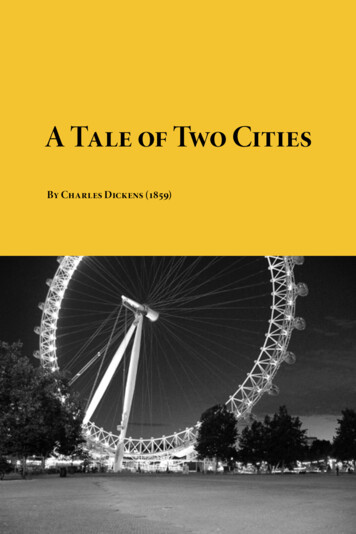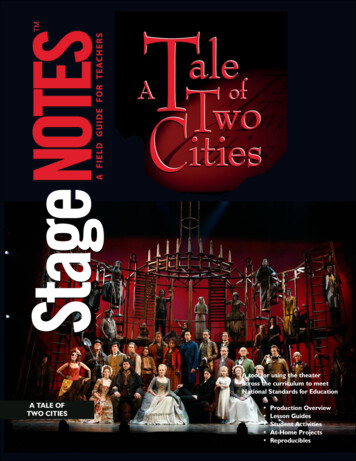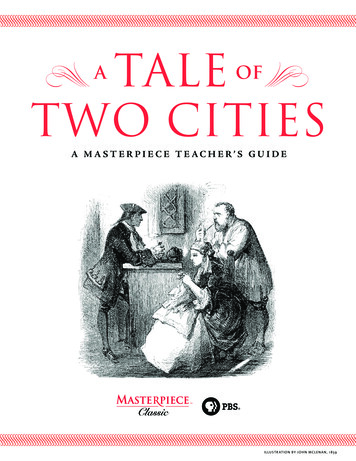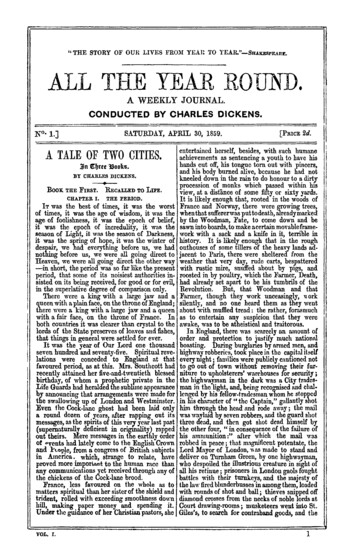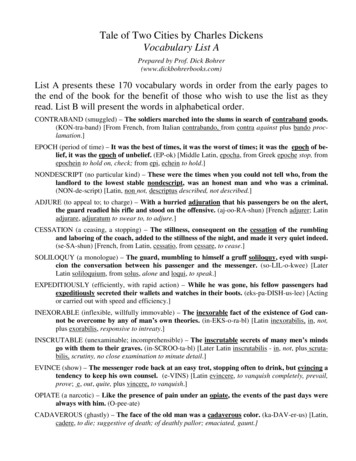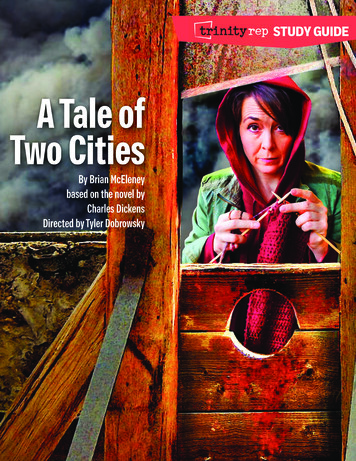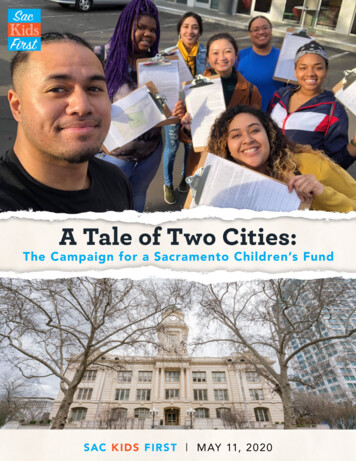
Transcription
A Tale of Two Cities:The Campaign for a Sacramento Children’s FundSAC K I DS FI R S T MAY 11, 2020
This paper was written by Jim Keddy with editorial assistance from Dr. Flojaune Cofer and Malaki Seku Amen. Jim serves as the treasurerof Sac Kids First (www.sackidsfirst.org) and as the executive director of Youth Forward (www.youth-forward.org). Sac Kids First is part ofFunding the Next Generation, a statewide network of child advocacy organizations (www.fundingthenextgeneration.org)
CONTENTSMeasure G2Who Voted For and Who Voted Against Measure G?3The Campaign Against Measure G5The Campaign For Measure G8The Public Debate Over Measure G10The Mayor’s Countermeasure11A Third Try12A Tale of Two Cities13Going Forward: Kids and the Coronavirus Pandemic14Endnotes15In this paper we explore the dynamics of race and class thatwere part of a 2020 ballot measure campaign that sought tostabilize and increase funding for children and youth servicesin the city of Sacramento. This analysis is meant to inform theongoing debate in Sacramento regarding funding for youthservices as well as to inform the various efforts underway inCalifornia and in the country to establish children’s funds in thebudgets of local governments.It is well-documented that California has an underfunded publicinfrastructure for children and youth, including underfundedpublic schools, child care, enrichment activities, afterschooland summer programs and youth development supports.1 Byanalyzing the Measure G campaign, we are able to shed somelight as to why this situation persists decade after decade, andwhy child advocates face a daunting, uphill struggle when itcomes to winning new youth investments. At the end of thepaper, we offer some reflections on Measure G in light of therecent coronavirus pandemic.It is well-documentedthat California has anunderfunded publicinfrastructure forchildren and youth,including underfundedpublic schools, childcare, enrichmentactivities, afterschooland summerprograms and youthdevelopment supports.Sac Kids First www.sackidsfirst.org April 20201
MEASURE GOn March 3rd, 2020, Sacramento voters had theapproved by voters, with 54% of voters inopportunity to vote for or against the Children’sopposition and 45% of voters in support.Fund Act of 2020, also known as Measure G.Measure G proposed to significantly increaseVoters across the city received considerablepriority given to children and youth mostarguments for and against in the county’s voterBecause of its focus on social and racial equity,from the opposition campaign and three mailersinvestments in children and youth, with ainformation about Measure G. In addition to theimpacted by poverty, violence and trauma.pamphlet, voters received four pieces of mailthe measure would have steered resourcestoward the most vulnerable youth, includingyouth of color, low-income youth, LGBT youth,foster youth and homeless young people. Thealso ran digital ads. Volunteers canvassed doorto door, phone banked and put up close to1,000 lawn signs. The proponents argued thatmeasure also would have created a strategicMeasure G would stabilize and increase fundingplanning and evaluation process, led by anfor youth services without raising taxes and thatoversight committee, to determine how to bestgiven the significant growth in the city budgetinvest the new funding.over the last several years, the City could affordMeasure G did not raise taxes. Instead, it2from the yes campaign. The yes campaignto spend more on children and youth.2would have required the City of SacramentoThe opponents sought to depict the measureto set aside 2.5% of general fund revenues foras dangerous, potentially limiting the city’schildren and youth and to not cut children’sability to respond to a natural disaster andservices (below existing funding levels) during ancausing cuts to police, fire, libraries and othereconomic downturn. The measure would havecity services.3 Mayor Darrell Steinberg, a long-required the City to do some reprioritizationstanding, well-regarded political leader in theof its existing funding. Measure G was notregion and a state leader on the homelessA Tale of Two Cities: The Campaign for a Sacramento Children’s Fund
crisis, opposed the measure, citing thefollowing rationale: 1). The city already spendsa lot of funding on youth 2). The measurewould cut into the city’s ability to fund essentialservices and to respond to the affordablehousing and homeless crisis and 3). He wouldcreate a better way through passing his ownyouth-focused ballot measure in the fall. MayorSteinberg and his allies saw Measure G as apotential threat to their plans to issue bondsto create an affordable housing trust fund. Thefirefighters union established the oppositioncommittee and made the largest contributionto the no campaign.WHO VOTED FOR AND WHO VOTED AGAINSTMEASURE G?An analysis of the votes for and against MeasureG reveals some stark differences. In general,neighborhoods that have a larger whitepopulation than the city average, and that alsohave a below average poverty rate overwhelmingopposed Measure G. In contrast, neighborhoodswith a smaller white population and a largerNeighborhoodLand ParkEast SacramentoPocketNorth NatomasPrecint #YES Vote NO Votepopulation of people of color, and that alsohave higher than average poverty rates, stronglysupported the measure.4 In the table at left beloware precinct data from the Sacramento CountyRegistrar of Voters that show how voters fromaffluent neighborhoods with an above averagewhite population voted on Measure G.NeighborhoodPrecint #YES Vote NO VoteDel Paso 127473762466906138145023366Avondale/Glen ElderValley High494576633498705643In contrast, voters in lower income neighborhoodsof color supported Measure G (see table on right).MeadowviewOak ParkFruitridgeSac Kids First www.sackidsfirst.org April 20203
For those not familiar with the geographySacramento. One would think that voters in theof Sacramento, it’s worth noting how thelower-income parts of the city would be moreneighborhoods that strongly opposedreceptive to the opposition argument regardingMeasure G are typically adjacent to those thatpossible future cuts to public services or asupported the measure. One can drive for onlypotential threat to the building of affordablefive minutes, from the mostly white and affluenthousing, since these voters are likely in greaterneighborhood of Land Park, in which votersneed of those services than those in the affluentopposed Measure G two-to-one, to the brownneighborhoods. Yet these voters did not followand black neighborhood of Oak Park, a fewthe mayor and supported Measure G.miles down the road, in which voters supportedWhile various factors influence how peopleMeasure G two-to-one. The same dynamicvote, the consistent contrast in voting patternsexists further south in the Pocket neighborhoodsuggests(more white andthat race andaffluent, votedincome playedagainst G) whichOnecandriveforonlyfiveminutes,a major factoris a little downin the electionthe road fromfrom the mostly white and affluentoutcome. le area strong Goften quicksupportervoters opposed Measure G two-to-one,to dismiss theand a Black/tothebrownandblackneighborhoodnotion that raceLatinx/S.E. Asiancontinues to playneighborhood.of Oak Park, a few miles down thea significant roleOr in the northernin how societypart of the city,road, in which voters supportedfunctions.6 Yet,some partsMeasureGtwo-to-one.these dataof Natomassuggest a clearvoted againstracial dynamicMeasure G,inhowpeoplevotedonMeasureG. People ofwhile their neighbors a few miles east, incolor in Sacramento have experienced historicNorth Sacramento and Del Paso Heights,and current day discrimination, oppression andvoted for the measure. Even within the samedisinvestment. The difference in experienceneighborhoods we can see this dynamic. Forbetween voters of color and white votersexample, voters in South Natomas largelyinfluences how these groups of voters view policysupported Measure G whereas voters in North5issues such as those represented by Measure G.Natomas vigorously opposed the measure.Given that voters in both types ofneighborhoods largely received the sameinformation about Measure G, we can seehow these voters, who live literally down theroad from one another, bring very differentperspectives to priorities for the city of4A Tale of Two Cities: The Campaign for a Sacramento Children’s FundIncidents like the 2018 shooting of Stephon Clarkreveal this vast difference in experience betweenthe white community and communities of color.In 2018, Sacramento made the national newswhen two police officers shot and killed StephonClark, an unarmed black man, in the backyard
of his grandmother’s home. The policeofficers were not charged and remain on thepolice force today. The shooting exacerbatedthe already existing trauma and fear inSacramento’s communities of color, particularlythe black community. The shooting also hada direct impact on the city budget. The Clarkfamily was awarded a 2.4 million settlement.7And, when police arrested 84 people during apeaceful protest in East Sacramento after nocharges were brought against the officers, 84people were wrongfully detained and arrested.Several weeks before the election, the City ofSacramento agreed to a 550,000 settlementto compensate the victims.8 This shooting costthe city almost 3 million in direct payouts inaddition to huge additional costs in police andcity staff overtime.THE CAMPAIGN AGAINST MEASURE GJust as we see a stark difference in race andincome among voters who supported themeasure and those who opposed, we see asimilar difference in who led and funded thecampaigns for and against Measure G.OrganizationDonations toNo on GSacramento Area Firefighters 40,000Sacramento Police Officers Union 31,000Plumbers Union 10,000Mayor Darrell SteinbergThe campaign against Measure G was fundedby some of the city’s most powerful and wellfunded interest groups, business leaders anddevelopers:9Donations toNo on GOrganizationElectrical Workers Union 10,000Building Industry Association 10,000Park West Casinos 10,000 15,000Kevin Nagle, CEO Sac Republic 10,000Sheet Metal Workers Union 10,000 10,000Councilmember Angelique Ashby 5,000Pacific Coast Companies(David Luccheti)Councilmember Steve Hansen 5,000 6,000Building Trades Council 10,000CC Yin (owner of 32 McDonaldsfranchises)California Apartment Association 5,0001801 L (luxury apartmentdevelopment) 5,000UnionSac Kids First www.sackidsfirst.org April 20205
The donations reveal a striking pattern, themost obvious of which is that no one outsidethe insider world of Sacramento power politicsdonated to the campaign against Measure G.In reviewing the donor list, it may strike someas curious that the police and fire unions andindividuals such as Kevin Nagle, the CEO ofthe Sacramento soccer team, and wealthydevelopers, would choose to get involvedin opposing a children’s measure. However,it becomes less curious when one takes intoaccount that the measure could have potentiallyimpacted their financial interests with the Cityof Sacramento. Police and fire budgets accountfor roughly two-thirds of the city’s general fund.While Measure G only would have directed asmall amount of additional funding (2.5%) toyouth services, it is likely that the police and fireunions viewed this minor reprioritization of cityspending as a threat to their financial position.10Business interests are also heavily engaged incity finances. For example, in November of lastyear, the City Council approved 27 million tosubsidize the construction of the new soccerstadium for Mr. Nagle’s team.10 Business leaders,construction unions and developers may haveopposed Measure G because of their belief thatthe measure might have impeded future plansto build affordable housing in the city. And, ofcourse, housing construction financially benefitsthese same interest groups.A significant part of the opposition campaignwas led by a Sacramento newspaper, InsidePublications. Inside Publications ran threeopposition articles by reporter R. E. Graswich,an op-ed and a paid ad, all against MeasureG, as well as one op-ed authored by theproponents.11 Inside Publications serves themore affluent and white neighborhoods of LandPark, Curtis Park and East Sacramento andcaters to the lifestyle and real estate interestsof well-to-do Sacramentans. It typically features6A Tale of Two Cities: The Campaign for a Sacramento Children’s Fundarticles on the arts, gardening, luxury homedesign, restaurants, charitable efforts andneighborhood challenges such as homelessnessand neighborhood development.In his articles regarding Measure G, R.E.Graswich ran a smear campaign against themeasure by implying that criminal nonprofitswould profit from the measure and use thefunding to benefit themselves, not youth. Inhis first article, months prior to the election, helabeled the proposed measure as a “nonprofitboondoggle” and focused on EBAYC, theorganization that works with Southeast Asianyouth in North and South Sacramento. In hisnext two articles, he associated the Measure Gcampaign with some financial mismanagementthat took place several years ago by a MeasureG supporter, the Roberts Family DevelopmentCenter (RFDC).12 The RFDC is a black-ledorganization that works successfully with youthof color in Sacramento’s most impoverishedneighborhood. In his articles, Graswichsought to discredit the numerous youthserving nonprofits and partners leading theMeasure G campaign by vigorously attackingone organization.13Media analysts refer to this sort of smear effortas a dog-whistle campaign.14 It is likely that thesearticles, appearing in a newspaper that primarilyserves a white readership, served to trigger theconscious and subconscious fears and racialresentment of white voters toward people ofcolor and toward organizations led by peopleof color. The white media has a long history ofportraying people of color, particularly AfricanAmericans, as criminals and as untrustworthy.Graswich sought to create fear and scandalaround Measure G and to move his readers tooppose the measure.
Sac Kids First www.sackidsfirst.org April 20207
The SacramentoKids First Coalitioncurrently consists of24 organizations thathave come together toadvocate for low-incomeyouth and youth of colorthroughout the city.The vast majority oforganizations in the SacKids First Coalition areled by people of color.THE CAMPAIGN FOR MEASURE GThe campaign for Measure G was initiatedby Southeast Asian youth leaders in SouthSacramento and Del Paso/North Sacramentoin 2016. These youth leaders, supported bythe nonprofit organization EBAYC, carriedout a survey of 1,500 low-income youthand youth of color, including young peopleincarcerated in the juvenile justice system, tobetter understand the situation and needs ofSacramento youth. At the same time theseyoung people and their adult supportersbegan the process of building the SacramentoKids First Coalition, a new effort determinedto increase supports for vulnerable youth.The Sacramento Kids First Coalition currentlyconsists of 24 organizations that have come8A Tale of Two Cities: The Campaign for a Sacramento Children’s Fundtogether to advocate for low-income youth andyouth of color throughout the city.15 Both youngpeople and adults lead the effort. The vastmajority of organizations in the Sac Kids FirstCoalition are led by people of color. Over 150youth and young adults volunteered during thesignature gathering phase and the campaignitself. The coalition has 1,200 individualsupporters. In addition to nonprofits that serveyouth, the coalition includes the SacramentoCity Teachers Association and the AmericanAcademy of Pediatrics. On the following pageis a list of member organizations.
EBAYCYouth ForwardSol CollectiveGreater Sacramento NAACPPRO Youth and FamiliesThe Sacramento LGBT CenterUnited LatinosLa Familia Counseling CenterSacramento Area Congregations TogetherRoberts Family Development CenterImprove Your TomorrowBlacks Making a DifferenceBrown Issues ForumThe Center at Sierra Health FoundationCalifornia Urban PartnershipGreenTech Education and EmploymentHealth Education CouncilSouth Sacramento Christian CenterRose Family Creative Empowerment CenterThe California Center for Civic ParticipationA.E.S/Sac Youth AllianceHmong Innovating PoliticsSacramento City Teachers AssociationCalifornia Chapter 1, American Academyof PediatricsThe Coalition initiated signature gatheringfor the Children’s Fund Act of 2020 in theFall of 2018. In April of 2019, the Coalitionsubmitted 39,000 valid signatures to the CityClerk. In November of 2019, the City Councilplaced the measure on the March 2020 ballot.During the campaign, young leaders of colorgathered signatures, canvassed, phone banked,distributed lawn signs and spoke at CityCouncil meetings.The campaign also benefitted from theendorsements of elected officials includingAssemblymember Kevin McCarty and threecity councilmembers. Among elected officials,Councilmember Jay Schenirer stepped forwardas the strongest supporter of the effort; heappeared in digital ads and in Yes on G mailers,and led the push to have the measure placedon the March ballot. The city’s largest dailynewspaper, The Sacramento Bee, endorsedthe measure.16The majority of the funding for the Yes onMeasure G campaign came from the memberorganizations of the coalition and from twoprominent child advocates.17 In addition tothe large contributions listed on the followingpage, Measure G received 178 donationsin smaller amounts from individuals andcommunity organizations since the inception ofthe overall campaign.9
OrganizationDonations toYes on GEBAYC 60,410Youth Forward 42,000The California Urban Partnership 30,000Child Advocate 25,000Child Advocate 25,000GreenTech Education and Employment 20,000Roberts Family Development Center 15,000THE PUBLIC DEBATE OVER MEASURE GAs with the prior examples, the public debateover Measure G exposed the racial andeconomic fault lines of the city. During thecampaign, Measure G was both supportedand opposed by local elected officials. Thisopposition and support largely broke downalong racial and economic lines. Three CityCouncilmembers (Ashby, Harris and Carr) signedthe ballot argument against the measure whilethree signed the measure in favor (Warren,Schenirer and Guerra).18 Ashby and Harrisrepresent two of the most affluent districtswhile Warren, Schenirer and Guerra representdistricts with a higher percentage of low-incomeresidents and residents of color. CouncilmemberHansen, also an opponent, represents thewealthy neighborhood of Land Park. The oneexception to this pattern is CouncilmemberLarry Carr, who opposed the measure due to hisconcern for ballot box budgeting; he representsthe lower-income Meadowview district. Amongthe leading non-incumbent candidates runningfor council seats on the March 2020 ballot, allthree candidates were people of color and allthree supported Measure G (Katie Valenzuela,Mai Vang and Pastor Les Simmons).10A Tale of Two Cities: The Campaign for a Sacramento Children’s FundAt the February 25th City Council meeting,Mayor Steinberg circumvented council protocoland rushed through his counterproposal toMeasure G, winning a 7-2 council vote to placehis alternative measure on the November2020 ballot. The Mayor introduced hiscountermeasure as part of his campaign todefeat Measure G. He made the argument tovoters, in voter mail and an opinion piece inThe Sacramento Bee, that his measure wasthe “better way.” He urged voters to opposeMeasure G and to support his measure inNovember, reassuring voters that even ifMeasure G failed, there would still be progressfor kids.At the February 25th Council debate, thevast majority of proponents of the Mayor’scountermeasure (and opponents to MeasureG) were white (white labor leaders, whiterepresentatives of the real estate industry,etc.).19 In contrast, almost all of the speakersexpressing support for Measure G, andconcern and opposition to the Mayor’s effortto undermine the measure, were young peopleof color.20 This racial dynamic with opponents
and supporters played out in other debateforums, such as the Measure G debate heldby the Sacramento Democratic Party CentralCommittee on January 9th, 2020.21THE MAYOR’S COUNTERMEASURESignificant differences exist between thealternative measure proposed by MayorSteinberg at the February 25th City Councilmeeting and Measure G. First, the alternativemeasure does not include any language thatwould prioritize the most vulnerable childrenand youth in the city.22 As such, the measuredoes not explicitly seek to increase racialequity and to close racial gaps when it comesto life opportunities for children and youth inSacramento.23had been leading a campaign for a youth fundsince 2016. The pursuit of racial equity entailsnot only distributing resources differently,but also directly engaging those marginalizedcommunities affected by the issue in developingsolutions.24 The Mayor also went against thecity’s own youth development plan, passedby the Council in 2017, which has as a guidingprinciple, “Nothing about us without us.”25By adopting this principle, city leaders tookthe stance that in developing policy that affectsyouth, they should consult and engage youngSecondly, the measure proposes to set aside apeople in the policy development process.smaller amount ofSeveral youthadditional fundingspeakers atfor youth servicesthe FebruaryThevastmajorityofproponentsofthan Measure25th CityG and does notCouncil meetingthe Mayor’s countermeasure (andcreate a stableexpressed theiropponentstoMeasureG)werewhite.funding source fordismay andyouth services. Theanger that theyIn contrast, almost all of the speakersmeasure wouldhad not beenexpressing support for Measure G, andset aside 20%consulted in theof growth in ty budget eachof the newyear for the youthmeasure.effort to undermine the measure, werefund, which wouldyoung people of color.be on averageFollowing 2.5 million perthe vote toyear, or less thanplace theone percent of the general fund. During a flatalternative measure on the November 2020year or economic downturn, there would be noballot, the Mayor and Council vowed to returnadditional funding for youth services.to a discussion of the alternative measure, toreceive public feedback, and to potentiallyFinally, Mayor Steinberg, in developing his newamend the measure. Councilmember Jaymeasure, neglected to notify or consult withSchenirer brought forward recommendations toany of the organizations or young people whoamend the measure and to bring the measureSac Kids First www.sackidsfirst.org April 202011
closer to Measure G, including equity languagethat would prioritize children most affectedby poverty, violence and trauma, as found inMeasure G. The Mayor responded positively tothis recommendation. Councilmember AllenWarren spoke strongly in support of Measure Gand in support of the need for greater attentionto racial equity. The Council has until earlysummer to amend the ballot proposal prior tothe November election, though it is unclearhow this timeline may be affected by thestatewide shelter in place directive in responseto the COVID-19 pandemic.A THIRD TRYMeasure G represents the third attempt bychildren’s advocates, educators and cityleaders in 4 years to pass a children’s fundingballot measure. Each of these attempts hasfailed. In June of 2016, Councilmember JaySchenirer attempted to create a children’s fundin the city budget by increasing city taxes onmarijuana businesses. In November of 2016, theSacramento City Unified Board of Educationsought to pass a school parcel tax to increaseenrichment activities and supports for at-riskyouth on school campuses. Both of thesemeasures would have required a two-thirdsvote to pass and both lost narrowly (65.86% and66.2% respectively). Each faced opposition,but nowhere near the opposition mountedagainst the Measure G campaign. Many of thecommunity groups that belong to the Sac KidsFirst coalition spent countless hours supportingthese campaigns, turning out volunteers tophone bank and canvass. The Sacramento CityTeachers Association, a Measure G supporter,also backed the 2016 measure.Some of the city’s political, business and unionleadership supported the above efforts, someopposed and some stayed on the sidelines.From the election outcomes, it’s clear thatthere has yet to be an effort large enough, andunited enough, to win. While there has yet tobe a united effort in support of kids, the city’sleaders have proven their ability to get things12A Tale of Two Cities: The Campaign for a Sacramento Children’s Funddone in other areas. Over the last several years,city leaders have built a new basketball arenaand entertainment center, laid the plans tobuild a new soccer arena and have filled thecity with attractive restaurants, art spaces andnew market rate housing. From reviewing thishistory to date, one may conclude that few, ifany, of the interests that drive the city budgetand development projects, treat low-incomechildren and children of color as a priority. Poorchildren have no significant financial interestadvocating for them in the political arena.
A TALE OF TWO CITIESThis paper has described the dynamics of theMeasure G campaign in order to lift up the racialand economic fault lines that divide the city.Children and youth across the city experiencegrowing up in Sacramento quite differentlybased on their race and family income level.For example, more affluent parents are ableto navigate the school system to locate theirchildren in the best public schools or they placetheir children in private schools. Low-incomechildren of color often attend public schoolswith fewer resources and lower academic rigorand with student populations with greaterneeds resulting from community traumasand concentrated poverty. These differencesare further compounded by the disparity inextracurricular youth supports. In the more whiteand affluent neighborhoods, parents typicallyhave the resources to place their children insummer and afterschool enrichment programsthat further their education. Low-incomechildren often have little or no access to suchprograms and fall behind academically duringthe summer months.In an unpublished op-ed submitted to theSacramento Bee, Dexter Niskala, a SoutheastAsian young adult active in EBAYC, shared whyhe got involved in the youth fund campaign asa 17 year-old at Luther Burbank High School:My mother brought me to Sacramento’s Meadowviewneighborhood from North Carolina when I was an8-year-old to start a new life away from addictionand domestic turmoil. My parents have longstruggled with jobs that didn’t pay enough to keepus in a stable home. By the time I got to Fern BaconMiddle School, we lost our home and we bouncedfrom house-to-house with friends and family untilwe exhausted our welcome. We ended up living onthe streets. One 2:00 am morning, police found measleep alone at a church parking lot and I was sent toa children’s receiving home for four months before Iwas reunited with my family.Child poverty is real and it’s widespread inSacramento. Living in poverty impacts how youngpeople feel about themselves and the choices theymake. I know a lot of youth who live with a lot oftrauma. And if not addressed, this often leads to depression, anger, violence, addiction,and more poverty.This is why I helped to create Measure G—Sacramento Children’s Fund Act of 2020—sothat a small portion of city revenue is invested in helping children and youth most impactedby poverty, violence, and trauma.”Dexter has been involved in all 3 campaigns to win an increase in funding for youth services over thelast 4 years.Sac Kids First www.sackidsfirst.org April 202013
GOING FORWARD: KIDS AND THECORONAVIRUS PANDEMICSuddenly, within days following the election, wefound ourselves in the midst of the coronaviruspandemic which is changing the policy,economic and political landscape in dramatic,unpredictable ways. Voters were becomingaware of the looming pandemic in the daysprior to the March 3rd election, which may havedepressed support for Measure G, and otheryouth and school measures around the state.26impact on low-income children. Families arestruggling to pay rent and are at even greaterrisk of homelessness. Parents are in even greaterneed of the supports for their children that wouldhave been funded by Measure G.Fortunately, at the February 25th City Councilmeeting, Mayor Steinberg and the Councilcommitted themselves to leading a campaign toestablish a childrenThe pandemic bringsand youth fund. In auncertainty to allletter mailed to votersThe families and children in theprior city plans foracross the city, Mayorneighborhoodsthatsupportedfuture investmentsSteinberg promisedin housingto lead an effort toMeasure G are bearing the brunt ofand economicincrease funding forthe pandemic-induced downturndevelopment, asyouth services and towell as the plan for aensure that, duringand will likely be affected over theNovember children’sa future downturn,long-term by the crisis.fund ballot measurebudget cuts wouldas proposed by Mayornot disproportionallySteinberg. It’s unclearimpact youthhow the pandemic will affect the economy, andprograms more than other city services.the city’s revenue picture over the long-term.Given this commitment, city leaders, childIt is possible that there will be a return to someadvocates, youth leaders and educatorsdegree of normalcy later in the year, but the pathwill have to work together to overcome theforward is unknown.inherent challenges to expanding the publicWhat is clear is that regardless
2 A Tale of Two Cities: The Campaig fo a acramento Children's und MEASURE G On March 3rd, 2020, Sacramento voters had the opportunity to vote for or against the Children's Fund Act of 2020, also known as Measure G. Measure G proposed to significantly increase investments in children and youth, with a priority given to children and youth most


